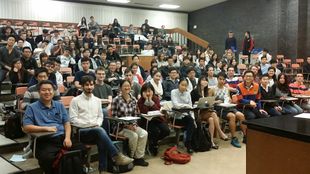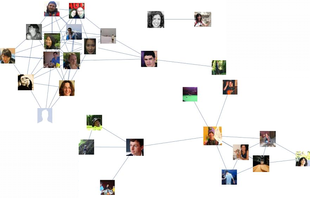15-344
Introduction to Combinatorics
Department of Mathematics, University of Toronto, Fall 2015
Agenda: Understand graphs and learn to count.
Instructor: Dror Bar-Natan, drorbn@math.toronto.edu (no math over email!), Bahen 6178, 416-946-5438. Office hours: by appointment.
Classes: Tuesdays 3-5 at MP 202 and Thursdays 2-3 at MP 203.
| Teaching Assistant: Gaurav Patil (g.patil@mail.utoronto.ca). Office hours: Mondays 3:30-4:30PM at 215 Huron, room 1012, and Tuesdays 6-7PM at math department lounge, on the 6th floor of the Bahen building.
Tutorials: Two sessions - Thursdays 4-5 and Thursdays 5-6, both at LM 158. |
Text
Our main text book will be Applied Combinatorics (sixth edition) by Alan Tucker, ISBN 978-0-470-45838-9; it is a required reading.
Further Resources
- 1999 class, by Steve Tanny.
- 2002 class, by Andres Del Junco.
- 2008 class, by Dilip Raghavan.
- My 15-344 notebook.
| Dror's notes above / Students' notes below |
(1). If you took MAT267 (also taught by Professor Bar-Natan), you may remember that Catalan number was discussed in a lecture.
Explore the Textbook
(Originally posted in the homework sectors after the corresponding homework was assigned, but moved to here for the readers' convenience.)
(2). For Problem 10, Section 2.3, you may wonder how to untangle the knot without induction. Here is a possible way.
Solution to Circle Coloring Problem (Tong Lin)
(3). In Problem 85, Section 5.2, we were asked to find the number of triangles formed by pieces of diagonals or outside edges of an n-gon, assuming throughout that no three lines were collinear. What if there is no such constraint? Attached are two papers that presented some general results.
15-344/The Number of Triangles Formed by Intersecting Diagonals of a Regular Polygon
15-344/The Number of Intersection Points Made by the Diagonals of a Regular Polygon
(4).In problem 29, Section 5.3, we were asked to prove that
, where .
It is tempting to think that this is a special case of some identity and that a general pattern can be found.
Replacing with any and with any gives
Does it hold, or can it be generalized to a greater extent?
Yes. We have the Multinomial_theorem.
, where and .
For a proof by induction, see here.
(5). If you are reading section 7.1 in our textbook, you may find example 3 intriguing. Attempting to solve the problem without looking for a recurrence relation, I found a solution using graph theoretic tools (to be precise, Euler's formula).
Graph Theory Revisited: Euler's Formula and a Combinatorial Problem (Tong Lin)













